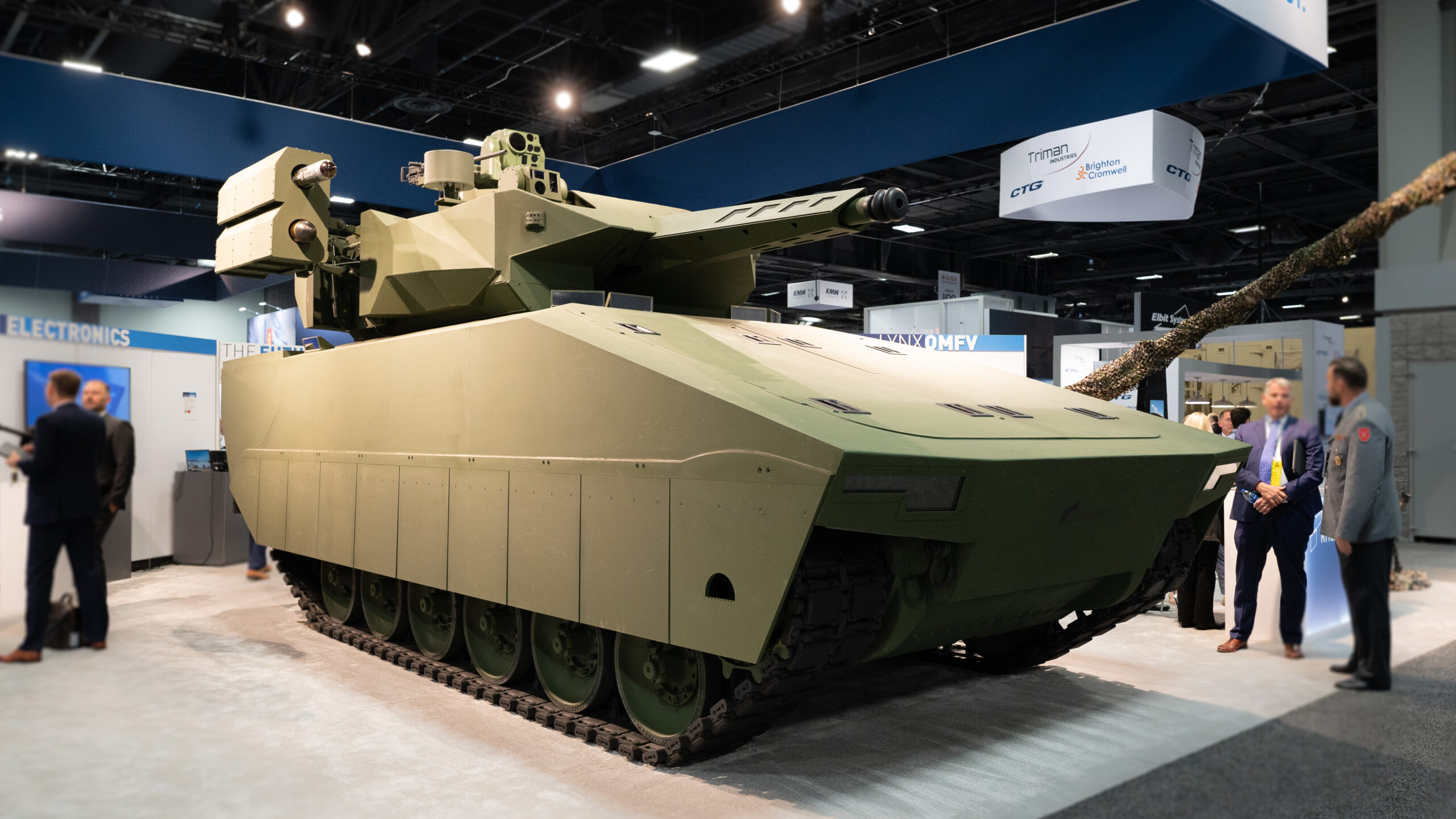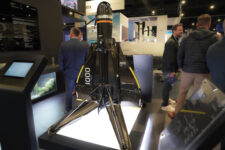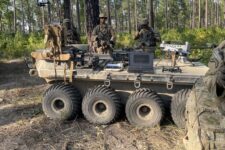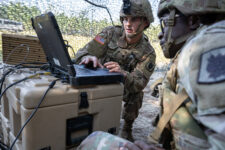
LYNX OMFV at AUSA 2022. (Breaking Defense/Brendon Smith)
GVSETS 2024 — The US Army has been using a new approach to handle the development of the XM30 Mechanized Infantry Combat Vehicle in which digital engineering — extensively employing computer simulations in design and production — is front and center.
“We can ensure that things are being done correctly, in the best way, before anything ever goes to manufacturing, saving a lot of costs upfront,” Product Manager of Prototype Development within PM-XM30, Program Executive Office, Ground Combat Systems (PEO GCS) Lt. Col. Michael Keathley told the audience at the 16th Annual Ground Vehicle Systems Engineering & Technology Symposium in Novi, Mich., on Wednesday.
For the program, digital engineering involves not only interrogating 3D models before going into production, but also ensuring modularity of the future platform tracing requirements and milestones as the program progresses.
Keathley said the methodology aligns with XM30’s mission statement, which comprises developing and delivering “a transformational vehicle in a transformational way.”
“Is this going to meet the requirement? Now we can know,” he said. “We can look into the design and objectively answer that question.”
Previously known as the Optionally Manned Fighting Vehicle, the XM-30 is an ongoing competition, meant to replace the Bradley Fighting Vehicle, which entered service in the 1980s. Last year the Army chose General Dynamics Land Systems and American Rheinmetall Vehicles to move to the design phase ahead of an expected 2027 downselect.
RELATED: Inside the US Army’s race to apply Ukraine lessons to future Abrams, Bradley replacement
Largely used by the commercial automotive industry to design and manufacture vehicles, digital engineering can provide insights into software development, anticipating issues that might impact the platform’s performance in the testing phases.
Moreover, for the Army, it can ensure compliance with Ground Combat Systems Common Infrastructure Architecture (GCIA) parameters by synchronizing the various sensors, systems and subsystems that will equip the future platform.
Speaking to Breaking Defense, Young Bang, Principal Deputy Assistant Secretary of the Army, Acquisition, Logistics, & Technology (ASA(ATL)), explained that the service has been pushing the digital engineering strategy. He stressed that XM30 competitors already provided a large number of interfaces to be evaluated and worked into the sub-components as part of the preliminary design.
“If we had a paper-based process, it would literally have taken us forever and a day to evaluate those types of design features,” Bang added. “So, the digital engineering model that they [vendors] and the team used helped them really accelerate the time that they can evaluate between 1,000 to 3,000 interfaces.”
From the Army’s perspective, this approach also enables better interaction and communication with suppliers. As XM30 competitors GDLS and Rheinmetall have been submitting sections of their designs every few weeks, the branch has been able to evaluate this information in the digital engineering environment and more rapidly offer feedback.
“We can catch errors before purchase orders have been issued. From a design perspective, you are getting greater confidence that what you are getting actually will meet the requirements,” Col. Jeffery Jurand, Project Manager XM30, PEO GCS, told the audience. “We are helping them [vendors] save money on a fixed price contract.”
From Bang’s perspective, it will help the service “get to the early analysis versus literally taking forever to find something down the road that we may have missed in our paper design process”.
Speaking to Breaking Defense, representatives of both GDLS and Rheinmetall said that this approach has been beneficial for their companies as well.
“The big advantage you get is being able to iterate faster, to start a program and get that program into the field faster,” Michael Milner, VP for Business Development Strategy at Rheinmetall, noted. “There is confidence that this program is moving in the right direction.”
A GDLS representative said, “One thing that is true about our modern world is change is inevitable, and change is continuing to affect the way the US military fights. … If we want to be truly responsive to that, we need to embrace the digital engineering”.
Both companies recently completed the preliminary design review (PDR), but neither could provide details about the process due to the competition’s guidelines.
GDLS is betting on the commonality of its XM30 design, with its Abrams tank and Stryker vehicle as well as on improvements in their capabilities. “We are trying to do things to the Army that is cutting- edge,” the company’s representative said.
Meanwhile, Rheinmetall is competing with a design based on its Lynx Infantry Fighting vehicle but with enhanced features. Milner claimed that “it is a truly next-generational design” that meets or exceeds all of the Army’s requirements.
RELATED: Germany’s Rheinmetall plans Lynx IFV production in Ukraine in ‘near future,’ CEO says
The company says it has been also advancing with its design. “There have been already some pre-built things, prefix hardware and tests” Chris Haag, Senior Director Business Development at Rheinmetall, said. “All the associated subsystems are going through that final maturation process ahead of us.”
Digital Engineering For All
Beyond its own program, the XM30 has been a pathfinder to support the implementation of digital engineering across other acquisition and development efforts, Army officials said. The Future Long-Range Assault Aircraft (FLRAA) is another initiative that has been using this approach.
“It is really critical for the Army to adopt digital engineering capabilities across all of our programs,” Jennifer Swanson, SES, Deputy Assistant Secretary of the Army (Data, Engineering, & Software) said. “Some of our programs already in those spaces are already implementing it, which is great, but there is still a lot for the Army to do and to learn from industry and a lot of collaboration. … I think that there is a huge increase in the success factor that digital engineering is really going to enable for XM30, for FLRAA and for all of our programs that are going after it.”
Keathley pointed out that the service is “definitely getting after” a transformation within the ground combat systems arena.
“The goal of all of this is to help you, the defense industrial base, to turn towards the digital engineering way of doing things and away from legacy-based platforms,” he said.






















